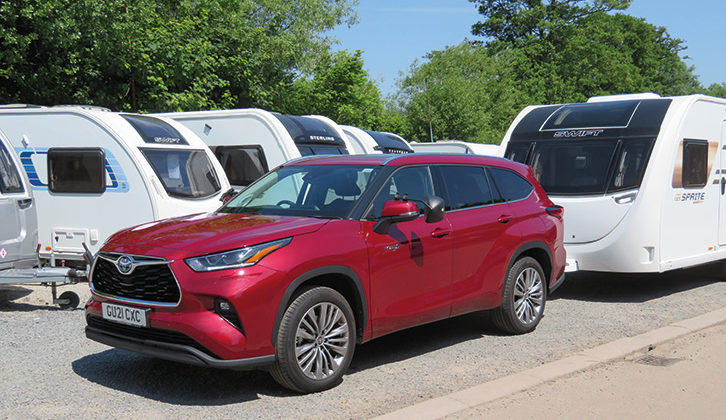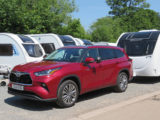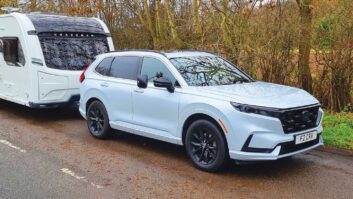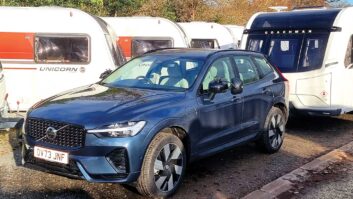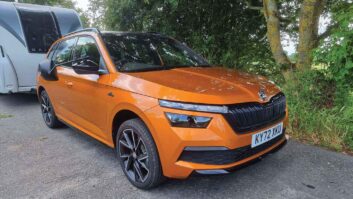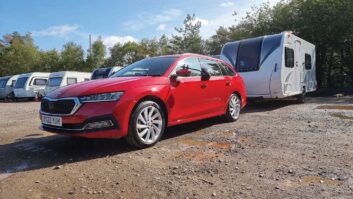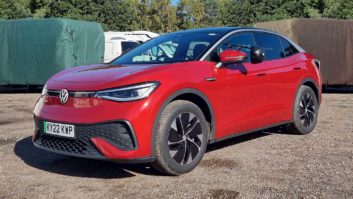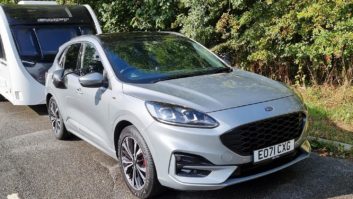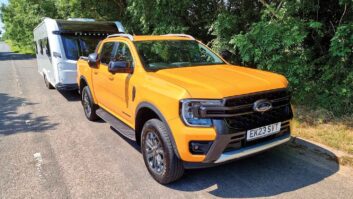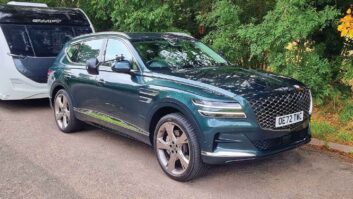Can the Toyota Highlander 2.5 Hybrid AWD-i Excel justify its price, or are there better and cheaper hybrid SUVs? How well does the big Toyota tow a caravan? David Motton finds out.
What’s new?
The Toyota Highlander has been around for more than 20 years, but the new generation is the first example to be sold in Britain.
It’s a similar size to the Land Cruiser, but the Highlander is engineered to be more at home on Tarmac. The best tow cars are able to cope with towing on a slippery surface and this, as a proper 4×4, should be up to the challenge.
Prices start from over £50,000, pitching the seven-seat Highlander between the Hyundai Santa Fe and Kia Sorento, and upmarket seven-seat SUVs from the likes of Audi and Land Rover. We’re testing the car in Excel spec, priced at £50,610.
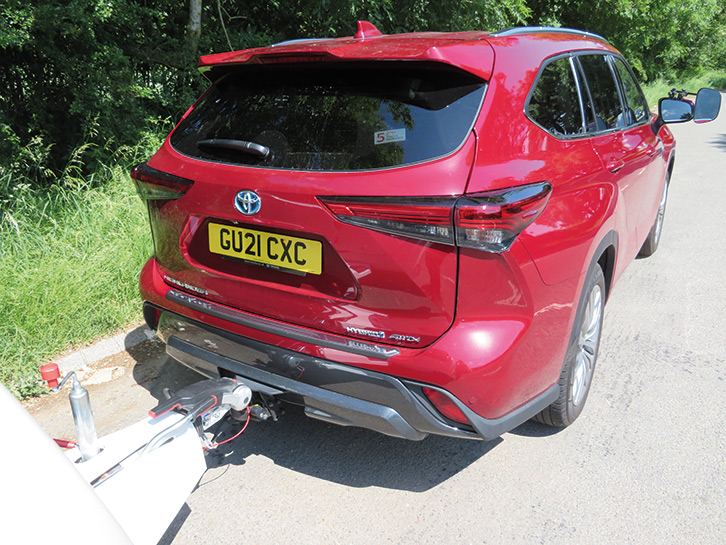
Towing ability
Some hybrids are hampered by their towing limits, but not the Highlander. It has a legal maximum of two tonnes, 350kg more than the equivalent Hyundai Santa Fe or Kia Sorento is permitted to tow.
Abiding by the 85% guideline, as widely recommended for safe and stable towing, the Highlander has an 85% match figure of 1743kg. So plenty of luxury vans make sensible matches. We paired it with a Sprite Super Major 4SB with a MiRO of 1390kg.
It’s a relatively light caravan for a car as heavy as the Highlander, but even so, the Toyota didn’t pull it as easily as a similar turbodiesel might have. When accelerating or trying to hold speed on hilly roads, the engine could be heard working hard as the auto transmission tried to extract full performance from the 248hp 2.5-litre petrol engine and the 134kW electric motor.
Stay away from hills and hold a steady speed and the Highlander is quiet, but there will be times when the engine revs hard and disturbs the hush in the cabin.
Quick it is not, but the Highlander is stable. Relatively soft suspension allows some pitching on undulating roads, but it keeps the caravan on a short leash. Even passing lorries on the motorway, there’s little side-to-side movement.
We’d be happy to tackle long journeys towing with the Highlander. There’s rarely any need to make steering corrections at a steady 60mph.
A 4×4 should breeze through a hill start, but the Highlander makes heavy work of it. On a 1-in-10 slope in dry weather, the electronic parking brake held car and van still. However, the 4×4 system only sends power to every corner once the front wheels struggle for grip, so the wheels spun at first, even though we intended to pull away gently. The ‘Trail’ mode sends more power to the rear wheels, and should make for a more controlled getaway, but won’t do much about the rowdy engine when building speed from a standing start.
Arrive at your site and the Highlander is easy enough to manoeuvre. Thick rear pillars hamper over-shoulder visibility, but with a rear-view camera and all-round parking sensors, that’s not an issue. The throttle and gearbox respond smoothly and predictably at low speeds.
There’s a space-saver spare under the car, and we could find no warning in the handbook about using it while towing.
The Highlander has a higher towing limit than many hybrid rivals, but its hill starting is tough work and the engine complains when working hard. Stability is what we look for above all else in a tow car, though, and the Highlander is secure at 60mph.
Solo driving
When you first drive the Highlander, it might seem a bit, well, bland. But the more time you spend with it, the more you come to appreciate its qualities.
Comfort is what the Highlander is all about, with suspension that’s been tuned for relaxed cruising rather than bounding down B-roads. Very sharp bumps can send a thump through the cabin, but otherwise it smooths the road admirably.
Long drives on motorways and A-roads are where the Highlander excels. Without the extra weight of a van to pull, the petrol engine is less rowdy. The instant pulling power of the electric motor means the Toyota drives away smartly, and it is quiet when running on electricity alone.
The smoother and more relaxed your approach to driving, the more you’ll like the Highlander. In fact, it positively encourages steady and smooth driving, because that’s how you enjoy the quietest driving experience. Press on, and the engine and gearbox rely on plenty of revs for any get-up-and-go.
Light steering, a rear-view camera and parking sensors mean that for such a big car (just short of five metres long), parking is straightforward. You’re aware of its size around town, but it’s not intimidating in the way that super-sized 4x4s such as the BMW X7 and Mercedes GLS can be.
Space and practicality
Something this big should have plenty of room for people, and on the whole, the Highlander is a very practical car.
In the front, drivers and passengers of all sizes have ample space to get comfortable, despite the panoramic sunroof stealing a little headroom. Electrical adjustment for the driver’s seat helps to fine-tune a supportive driving position, and we drove hundreds of miles without so much as a twinge.
The dash is solidly built, as you’d expect of a Toyota, but doesn’t have the premium feel or design flair many expect of a car costing over £50,000.
With knobs and buttons for the air conditioning, rather than touch pads or touchscreen menus, the Toyota looks a little old-fashioned. But we’ll take proper buttons over minimalist design that puts fashion above ease of use any day of the week.
The infotainment screen is rather small compared with those found in some premium rivals, and the graphics aren’t as crisp, but technophobes will probably welcome the short-cut buttons surrounding the screen.
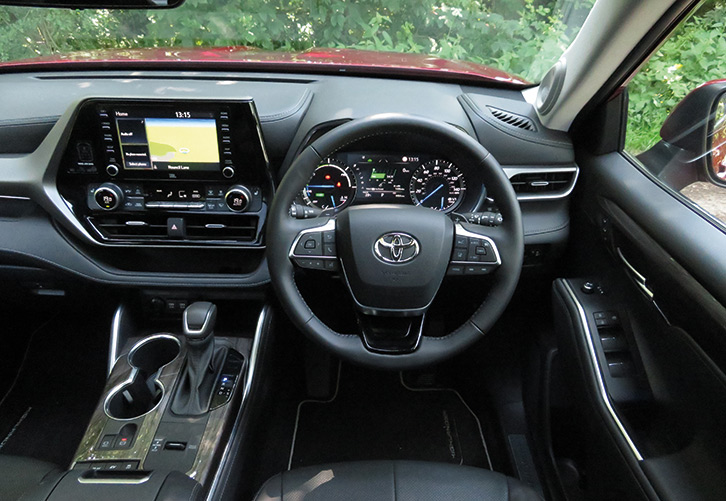
In the middle row, adults should get comfortable with room to spare. The floor is almost flat and the cabin very wide, so three passengers can travel in the back without feeling squashed together.
The seats recline if any passenger wants to take a nap, or slide forwards to make more legroom in the third row.
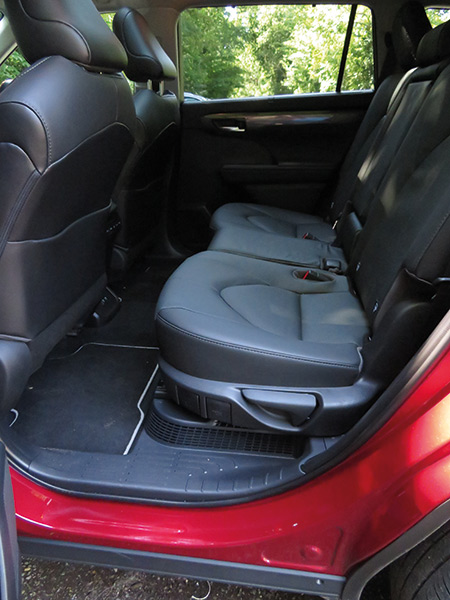
Those in seats six and seven won’t be happy for long unless the middle-row passengers are in a generous mood. With the middle row all the way back, there’s slightly less room than you get in the third row of a Kia Sorento, for example. However, it’s good to see air vents for all three rows.
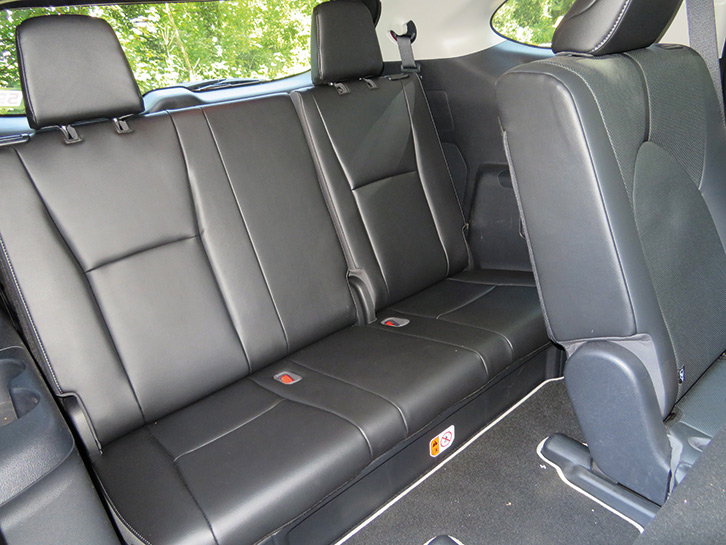
There’s enough luggage space for several shopping bags with every seat in place, and loads of room for holiday suitcases with the back seats folded away.
Buying and owning
The Toyota looks pricey next to the Kia Sorento full hybrid, which tops out at £47,610. The Highlander costs another £3000 if you go for the entry-level Excel, rising to £52,590 for
the Excel Premium.
On the other hand, the Excel has not been specified like an entry-level vehicle, with leather upholstery, satellite navigation, a suite of welcome driver aids, heated front seats and a heated steering wheel.
The official combined fuel economy figure of 39.2-39.7mpg compares well with 38.2mpg for the equivalent Hyundai Santa Fe. While towing, we achieved 24.3mpg. That’s reasonable for a car of this size, and compares well with the 22.1mpg that was achieved by the Kia Sorento hybrid when we towed with it, albeit it pulling a slightly heavier caravan.
Toyota deserves its excellent reputation for reliability, and there’s a 10-year, 100,000-mile warranty for owners who continue to have their car serviced within the brand’s dealership network.
A three-year, 60,000-mile warranty is standard if you choose to have the vehicle serviced elsewhere.
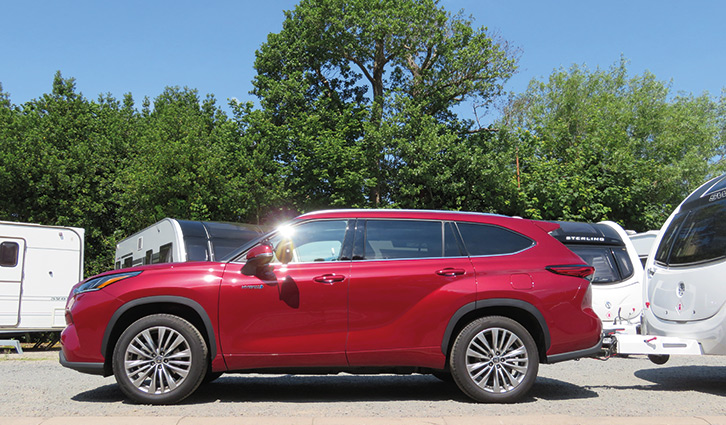
Verdict
It’s a slow-burner, the Toyota Highlander. The looks, cabin and driving experience seem a bit anonymous at first. Certainly, if you are looking for the last word in style or some real excitement, the Highlander is probably not for you.
The more time you spend with the Toyota, however, the more you come to respect its talents. Drive gently and this is an impressively comfortable vehicle, and a very quiet one. Combine these qualities with a high-up driving position and a comfortable seat and you have a car ideally suited to long-distance driving.
It performs well on shorter hops, too, because those stop-start journeys will provide the battery with ample opportunity to recharge.
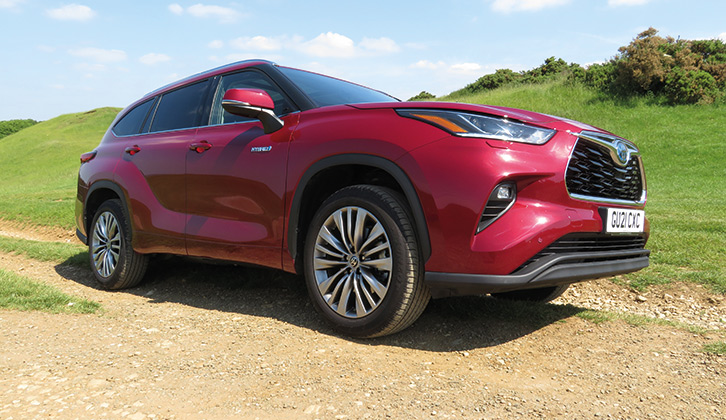
As a tow car, acceleration is a bit steady by the standards of £50,000 offroaders, and you need to work the engine hard. However, the gruff complaint under the bonnet then undermines the quiet refinement that’s so appealing about the car when driven gently.
We’ve no complaints at all about its stability. Solo or towing, it makes a fine companion on a lengthy trip. It’s practical, too, with lots of space in the first two rows (and the third, with the middle row moved forward).
The trouble is, the Hyundai Santa Fe and Kia Sorento hybrids are significantly cheaper. The Highlander has a higher towing limit than either, but unless you plan to tow a heavier caravan than either of these cars can handle, we think they are better value.
If you’re after more inspiration, take a look at our best hybrid tow car guide to see our top picks on the market.
Technical spec
- Price £50,610
- Kerbweight 2050-2105kg
- 85% of kerbweight From 1743kg
- Gross vehicle weight 2720kg
- Max towing limit 2000kg
- Gross train weight 4720kg
- Towball limit 80kg
- Price of towball and electrics £749
- Boot size min/max 332/1909 litres
- Payload 670kg
- Test conditions Dry
- Engine size 2487cc
- Power (hp)/rpm 248/Not stated
- Torque (lb ft)/rpm 149/4300-4500
- Official combined economy 39.2-39.7mpg
- Towing economy 24.3mpg
- CO2 emissions 159-163g/km
- First year car tax £545
- Second year car tax £480
- Insurance group 40P
Or you could try these:
Audi Q7: we find out whether one of the plug-in hybrid models matches the towing ability of a diesel Q7.
Ford Kuga 2.0 EcoBlue 150PS MHEV ST-Line X FWD: we thought there was untapped potential in this tow car so we put it to the test.
If you’ve enjoyed reading this article, why not get the latest news, reviews and features delivered direct to your door or inbox every month. Take advantage of our brilliant Practical Caravan magazine SUBSCRIBERS’ OFFER and SIGN UP TO OUR NEWSLETTER for regular weekly updates on all things caravan related.
Technical Specifications
| Engine Size | 2487 cc |
| Kerbweight | 2050-2105 kg |
| 85% KW | from 1743 kg |
| Towball Limit | 80 kg |
| Maximum Towing Limit | 2000 kg |
| Power | 248 bhp |
| Torque | 149 lb ft |
| Offical MPG | 39.2-39.7 mpg |
| Towing MPG | 24.3 mpg |
| CO₂ | 159-163 g/km |
